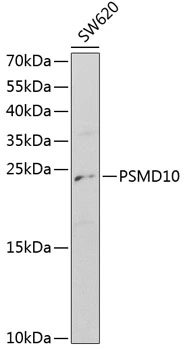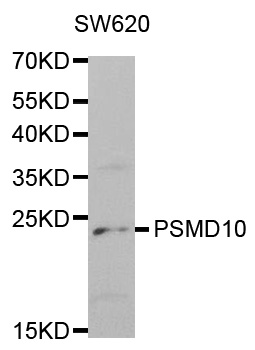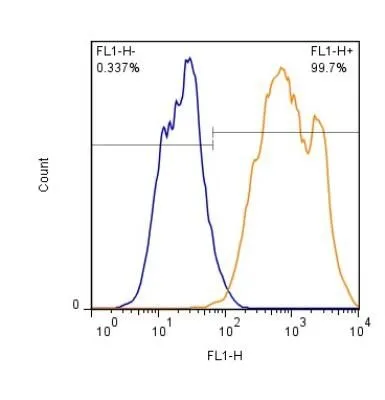
FACS (Intracellular staining) analysis of Jurkat cells using GTX48519 PSMD10 antibody. Orange : Primary antibody Blue : secondary antibody control Dilution : 1:500
PSMD10 antibody
GTX48519
ApplicationsFlow Cytometry, ImmunoFluorescence, Western Blot, ImmunoCytoChemistry
Product group Antibodies
TargetPSMD10
Overview
- SupplierGeneTex
- Product NamePSMD10 antibody
- Delivery Days Customer9
- Application Supplier NoteWB: 2 microg/ml. ICC/IF: 1:500. FACS: 1:500. *Optimal dilutions/concentrations should be determined by the researcher.Not tested in other applications.
- ApplicationsFlow Cytometry, ImmunoFluorescence, Western Blot, ImmunoCytoChemistry
- CertificationResearch Use Only
- ClonalityPolyclonal
- Concentration0.97 mg/ml
- ConjugateUnconjugated
- Gene ID5716
- Target namePSMD10
- Target descriptionproteasome 26S subunit, non-ATPase 10
- Target synonymsdJ889N15.2, p28, p28(GANK), 26S proteasome non-ATPase regulatory subunit 10, 26S proteasome regulatory subunit p28, ankyrin repeat protein, gankyrin, hepatocellular carcinoma-associated protein p28-II, proteasome (prosome, macropain) 26S subunit, non-ATPase, 10
- HostRabbit
- IsotypeIgG
- Protein IDO75832
- Protein Name26S proteasome non-ATPase regulatory subunit 10
- Scientific DescriptionThe 26S proteasome is a multicatalytic proteinase complex with a highly ordered structure composed of 2 complexes, a 20S core and a 19S regulator. The 20S core is composed of 4 rings of 28 non-identical subunits; 2 rings are composed of 7 alpha subunits and 2 rings are composed of 7 beta subunits. The 19S regulator is composed of a base, which contains 6 ATPase subunits and 2 non-ATPase subunits, and a lid, which contains up to 10 non-ATPase subunits. Proteasomes are distributed throughout eukaryotic cells at a high concentration and cleave peptides in an ATP/ubiquitin-dependent process in a non-lysosomal pathway. An essential function of a modified proteasome, the immunoproteasome, is the processing of class I MHC peptides. This gene encodes a non-ATPase subunit of the 19S regulator. Two transcripts encoding different isoforms have been described. Pseudogenes have been identified on chromosomes 3 and 20. [provided by RefSeq]
- Storage Instruction-20°C or -80°C,2°C to 8°C
- UNSPSC12352203
References
- TGF-beta1 signaling pathway serves a role in HepG2 cell regulation by affecting the protein expression of PCNA, gankyrin, p115, XIAP and survivin. Wang XH et al., 2017 May, Oncol LettRead more

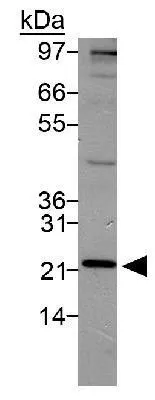
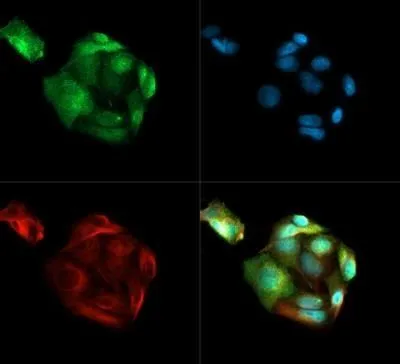

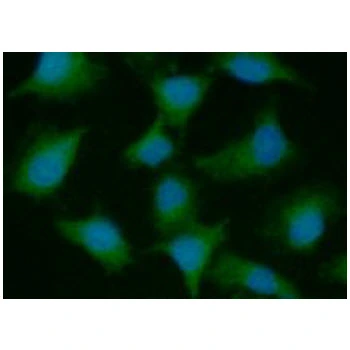
![FACS analysis of HeLa cells using GTX83773 PSMD10 antibody [3F6]. Red : Primary antibody Blue : Negative control antibody](https://www.genetex.com/upload/website/prouct_img/normal/GTX83773/GTX83773_178_FACS_w_23061420_647.webp)
